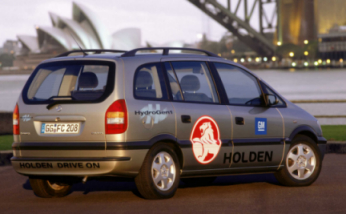
This Week:
- Egery,
the First Internet Company Dedicated to European Drivers, To Unveil
Initial Service Offer at the Paris Auto Show
- Honda
Expands Production of General-Purpose Engines in North Carolina
. - TMC
to Bolster Latin American Operations
. - Chrysler Brand to Unleash Minivan Advertising Campaign For Its All-New 2001 Voyager and Town & Country
- General
Motors Inaugurates GM Tradexchange in Europe
. - Lear
Corporation Announces Plans to Open New Manufacturing Operation in
Germany
. - Michael Johnston Joins Visteon Leadership As President and Chief Operating Officer
© 1998
- 2000 Copyright &
Disclaimer
Automotive Intelligence,
www.autointell.com
All Rights Reserved .
For questions please contact
editor@autointell.com

News of September 12, 2000
|
"HYDROGEN1"
At The Sydney Olympics |
|
Opel "Hydrogen1" Photo: Opel |
|
Rüsselsheim,
Germany - Holden (General Motors' Australian affiliate) will showcase a
leading edge, zero-emission concept vehicle developed by Opel, during
the Sydney 2000 Olympic Games. Known as "HydroGen1", the fuel
cell vehicle that runs on pure hydrogen has been selected to lead the
men's and women's Olympic marathons in Sydney on September 24 and
October 1 respectively. "We
think it is extremely appropriate that a vehicle that is leading the way
in future fuel technology will also lead the world's best long-distance
runners in this legendary Olympic contest," said Holden Chairman
and Managing Director, Peter Hanenberger. "It is a demonstration of
General Motors' commitment to technological and environmental leadership
and more specifically to producing vehicles which offer economical use
of resources," he added. Based
on Opel's Zafira compact van (which Holden will be introducing to the
Australian market early next year), "HydroGen1" complements
the 3500-strong vehicle fleet Holden is supplying as Official Olympic
Partner for the Sydney 2000 Olympic Games and Provider to the Sydney
2000 Olympic Torch Relay. In
keeping with the 'Green Games' philosophy of the Sydney 2000 Olympic
Games, "HydroGen1" is entirely pollutant-free. It emits only
water vapor. It is a forerunner of tomorrow's cars, representing another
major step forward on the way to a volume-production, fuel cell vehicle.
GM researchers and engineers view fuel cell propulsion as an ideal
platform for vehicles ranging from personal use, to commercial trucks to
transit buses and trains, and they believe that high-volume production
is achievable this decade. "HydroGen1"
is an advanced, road-going concept car which already meets the demands
of everyday driving. Propelled by a 55 kW / 75 hp three-phase electric
motor, it is a five-seater with a top speed of 140km/h and a range of
about 400 kilometers. The electric current is generated by a fuel cell
stack that consumes pure hydrogen. The stack consists of 200 individual
cells arranged in series and measuring only 590 x 270 by 500 millimeters
(length x width x height), making it just as compact as a conventional
gasoline or diesel engine. Its continuous power output is 80 kW / 109 hp
and its peak output 120 kW / 163 hp. The liquified hydrogen is
transported in a specially insulated, 75-liter tank at minus 253 degrees
Centigrade. The
vehicle was developed at GM's Global Alternative Propulsion Center (GAPC)
located in Mainz-Kastel, Germany; Rochester, New York (U.S.A.); and
Warren, Michigan (U.S.A.). For the 250 specialists at GAPC, the most
important future objectives include developing lighter and more compact
fuel storage technologies and contributing to the development of the
infrastructure that will ensure widespread availability of hydrogen.
According to GAPC Co-Director Dr. Erhard Schubert, "hydrogen is
most definitely the fuel of the future. A propulsion system using
hydrogen fuel cells has optimum efficiency, emits nothing but water
vapor, runs practically noise-free and, at the same time, is fun to
drive." "HydroGen1"
is one aspect of GM's transportation vision as expressed earlier this
year by Vice Chairman Harry J. Pearce: "At General Motors we
believe that we will indeed have a hydrogen based transportation system
sometime in the future and we are perhaps not smart enough to predict
precisely when that is going to be. But it will indeed occur in our
judgement." (September
7, 2000) |
[Homepage] [
News] [ Companies] [
Management] [ Publications]
[ Events] [ Careers]
[Services] [Discussion] [
Guestbook]
[ Search]
